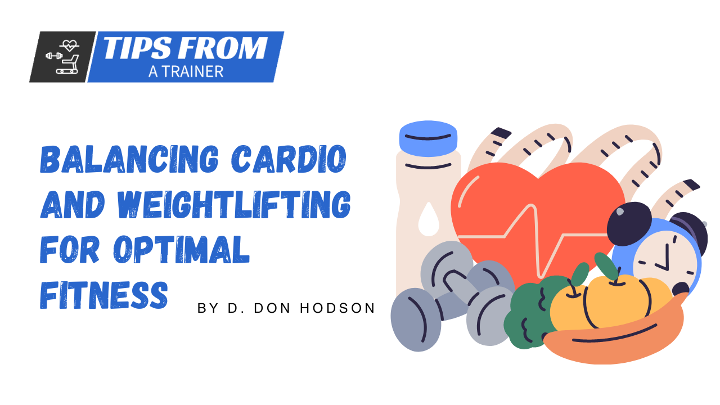Introduction
Welcome to an exploration of the symbiotic relationship between cardiovascular exercise and weightlifting – two cornerstones of physical fitness that converge to sculpt a resilient and robust physique. In this comprehensive article, we dissect the physiological and psychological benefits of each modality and uncover the nuanced interplay that propels us towards optimal well-being.
Cardiovascular exercise, exemplified by activities such as running, cycling, and swimming, is a catalyst for enhanced heart health, endurance, and stress reduction. It establishes a strong cardiovascular foundation, an indispensable prelude to the intricate art of weightlifting. The latter, encapsulating compound and isolation exercises, strengthens muscles, fosters functional capability, and contributes to the intricate tapestry of physical resilience.
By harmonizing the frequencies of cardiovascular exertion and weightlifting precision, we embark on a journey of holistic transformation that transcends mere routine, ushering us towards the zenith of our fitness aspirations.
Table of Contents
Introduction
The Benefits of Cardiovascular Exercise
Types of Cardiovascular Exercise
Frequency and Duration
The Role of Weightlifting in Fitness
The Benefits of Weightlifting
Weightlifting Techniques
Frequency and Consistency
The Synergy Between Cardio and Weightlifting
Building a Strong Foundation
Promoting Fat Loss
Balancing Priorities
Designing a Balanced Fitness Program
Setting Clear Goals
Creating a Weekly Schedule
Integrating Cardio and Weightlifting
Progressive Overload and Periodization
Cardiovascular Exercise for Endurance and Health
Endurance Training Techniques
Heart Health and Cardiovascular Benefits
Mental and Emotional Well-being
Cross-Training and Variation
Strength Training for Muscle Development and Toning
Benefits of Strength Training
Resistance Training Techniques
Progressive Overload and Technique
Muscle Toning and Definition
Create a Balanced Routine
Determining Your Fitness Goals
Frequency and Duration
Combining Cardio and Strength Training
Recovery and Rest Days
Nutrition for Performance and Recovery
Pre-Workout Nutrition
Intra-Workout Nutrition
Post-Workout Nutrition
Hydration
Progressive Overload and Adaptation
Understanding Progressive Overload
Tracking and Progression
Periodization
Recovery and De-loading
Listen to Your Body and Modify Accordingly
Signs of Overtraining or Injury
Rest and Active Recovery
Seeking Professional Guidance
Adjusting Your Routine
Consistency and Progress
Establishing a Routine
Tracking Your Progress
Measuring Performance
Celebrating Milestones
Staying Motivated and Enjoying the Process
Setting Realistic Goals
Variety and Fun
Accountability and Support
Mindset and Positive Reinforcement
Conclusion

The Benefits of Cardiovascular Exercise
- Cardiovascular exercise improves heart health by strengthening the heart muscle and reducing the risk of heart disease.
- It helps in weight management by burning calories and promoting fat loss.
- Cardio boosts your mood and reduces stress by releasing endorphins, the feel-good hormones.
- It enhances lung capacity and improves overall respiratory function.
- Regular cardio exercise can improve sleep quality and promote better overall sleep patterns.
Types of Cardiovascular Exercise
Running and Jogging
- Running and jogging are effective cardio exercises that can be performed outdoors or on a treadmill.
- They help improve cardiovascular endurance, burn calories, and strengthen leg muscles.
Cycling
- Cycling is a low-impact cardio exercise that can be done outdoors or on a stationary bike.
- It targets the lower body, particularly the leg muscles, and is suitable for all fitness levels.
Swimming
- Swimming is a full-body cardio exercise that is gentle on the joints.
- It engages multiple muscle groups, improves cardiovascular fitness, and increases overall endurance.
Frequency and Duration
- The American Heart Association recommends at least 150 minutes of moderate-intensity cardio or 75 minutes of vigorous-intensity cardio per week.
- You can divide your cardio sessions into multiple days or choose longer sessions based on your fitness level and goals.
The Role of Weightlifting in Fitness
Weightlifting, also known as strength training or resistance training, involves using external resistance to build muscle strength and endurance. In this section, we will explore the benefits and principles of weightlifting for optimal fitness.
The Benefits of Weightlifting
- Weightlifting helps increase muscle mass and strength, leading to improved overall body composition.
- It boosts metabolism, as muscles require more energy to maintain than fat.
- Weightlifting enhances bone density and reduces the risk of osteoporosis.
- It improves joint stability and functionality, reducing the risk of injuries.
- Weightlifting positively impacts mental health by promoting self-confidence and improving body image.
Weightlifting Techniques
Compound Exercises
- Compound exercises involve multiple muscle groups and joints, such as squats, deadlifts, and bench presses.
- These exercises provide functional strength and improve overall muscle coordination.
Isolation Exercises:
- Isolation exercises target specific muscle groups, such as bicep curls, tricep extensions, and calf raises.
- They are useful for targeting weaker muscles or addressing muscular imbalances.
Frequency and Intensity
- To see significant strength and muscle gains, it is recommended to weightlift at least two to three times a week.
- Beginners can start with lighter weights and gradually increase the intensity as they progress.
The Synergy Between Cardio and Weightlifting
Finding the right balance between cardiovascular exercise and weightlifting is crucial for achieving optimal fitness results. In this section, we will explore how these two components complement each other and contribute to overall fitness.
Building a Strong Foundation
- Cardiovascular exercise improves endurance and prepares the body for weightlifting sessions.
- A solid cardiovascular base enhances recovery, promotes circulation, and delivers essential nutrients to muscles.
Promoting Fat Loss
- Cardio exercises, such as high-intensity interval training (HIIT), are effective for burning calories and reducing body fat.
- Weightlifting helps increase muscle mass, which further enhances the body's metabolic rate, even at rest.
Balancing Priorities
- The frequency and intensity of cardio and weightlifting should be balanced according to individual goals and preferences.
- For those focusing on muscle building, reducing cardio volume while maintaining cardiovascular health is important.
Designing a Balanced Fitness Program
In this section, we will discuss the key considerations for designing a well-rounded fitness program that incorporates both cardio and weightlifting.
Setting Clear Goals
- Identify your specific fitness goals, such as improving cardiovascular endurance, building muscle, or losing weight.
- Having clear goals will help you structure your program accordingly and track your progress effectively.
Creating a Weekly Schedule
- Determine how many days per week you can commit to exercise.
- Allocate specific days for cardio sessions, weightlifting workouts, and rest days.
Integrating Cardio and Weightlifting
- Alternate cardio and weightlifting sessions to allow for adequate recovery between muscle groups.
- Consider incorporating hybrid workouts, such as circuit training or functional training, that combine elements of both cardio and weightlifting.
Progressive Overload and Periodization
- Gradually increase the intensity, duration, or resistance of your workouts over time to continue challenging your body.
- Implement periodization strategies, such as varying training phases, to optimize results and prevent plateaus.
Cardiovascular Exercise for Endurance and Health
In this section, we will explore how cardiovascular exercise contributes to endurance, overall health, and its specific benefits for the body.
Endurance Training Techniques
Long-Distance Running
- Long-distance running builds stamina and endurance by challenging the cardiovascular system over extended periods.
- Gradually increase your distance and pace to improve endurance gradually.
Interval Training
- Interval training combines high-intensity bursts of exercise with short recovery periods.
- It helps improve cardiovascular capacity and allows you to work at higher intensities.
Fartlek Training
- Fartlek training involves alternating between periods of moderate jogging and faster sprints.
- This technique helps improve speed, endurance, and overall cardiovascular fitness.
Heart Health and Cardiovascular Benefits
- Regular cardiovascular exercise reduces the risk of heart disease, lowers blood pressure, and improves blood circulation.
- It helps lower LDL (bad) cholesterol levels and increases HDL (good) cholesterol, promoting a healthy heart.
Mental and Emotional Well-being
- Cardiovascular exercise releases endorphins, which elevate mood and reduce symptoms of depression and anxiety.
- It provides an opportunity to relieve stress, clear the mind, and improve overall mental well-being.
Cross-Training and Variation
- Incorporate various cardiovascular exercises into your routine, such as swimming, cycling, or using an elliptical machine.
- Cross-training helps prevent boredom, challenges different muscle groups, and promotes overall fitness.
Strength Training for Muscle Development and Toning
In this section, we will discuss the role of strength training in building muscle, toning the body, and improving overall strength and functionality.
Benefits of Strength Training
- Strength training increases muscle mass, enhances muscle definition, and shapes the body.
- It improves overall strength and functionality, making daily activities easier and reducing the risk of injury.
Resistance Training Techniques
Compound Movements
- Compound exercises, such as squats, deadlifts, and bench presses, target multiple muscle groups simultaneously.
- They stimulate muscle growth, improve coordination, and promote overall strength development.
Isolation Movements
- Isolation exercises, such as bicep curls, tricep extensions, and calf raises, focus on specific muscle groups.
- These exercises allow you to target and strengthen individual muscles.
Progressive Overload and Technique
- Incorporate progressive overload by gradually increasing the weight, repetitions, or sets in your strength training routine.
- Focus on maintaining proper form and technique to maximize muscle engagement and minimize the risk of injury.
Muscle Toning and Definition
- To achieve muscle tone and definition, combine resistance training with higher repetitions and lower weights.
- Incorporate supersets, drop sets, or other intensity techniques to challenge your muscles further.
Creating a Balanced Routine
In this section, we will discuss how to create a balanced fitness routine that incorporates both cardiovascular exercise and strength training for optimal results.
Determining Your Fitness Goals
- Assess your goals, whether they are focused on building strength, improving endurance, or achieving a balanced physique.
- Understanding your priorities will help you structure your routine accordingly.
Frequency and Duration
- Aim for at least three to five days of cardio workouts per week, incorporating a mix of moderate and high-intensity sessions.
- Schedule two to three days for strength training, allowing for adequate rest and recovery.
Combining Cardio and Strength Training
- Alternate between cardio and strength training days to ensure balanced workload and muscle recovery.
- Consider incorporating hybrid workouts, such as circuit training or HIIT, that combine elements of both cardio and strength training.
Recovery and Rest Days
- Include rest days in your routine to allow your body to recover and adapt to the demands of exercise.
- Prioritize sleep, proper nutrition, and active recovery techniques, such as stretching or foam rolling.
Nutrition for Performance and Recovery
In this section, we will explore the importance of nutrition in supporting your fitness goals, fueling workouts, and promoting effective recovery.
Pre-Workout Nutrition
- Prioritize consuming a balanced meal or snack that includes carbohydrates for energy and protein for muscle support.
- Opt for complex carbohydrates, such as whole grains, fruits, and vegetables, and lean sources of protein.
Intra-Workout Nutrition
- Consider consuming a small snack or sports drink during prolonged or intense workouts to maintain energy levels.
- Choose easily digestible carbohydrates, such as a banana or a sports gel, to provide immediate fuel.
Post-Workout Nutrition
- After workouts, aim to consume a combination of protein and carbohydrates within the first hour to support muscle recovery.
- Opt for lean protein sources like chicken, fish, or plant-based options, along with complex carbohydrates.
Hydration
- Proper hydration is crucial for optimal performance and recovery.
- Drink water before, during, and after your workouts, and consider incorporating electrolyte-rich beverages for longer sessions.
Progressive Overload and Adaptation
In this section, we will discuss the concept of progressive overload and how it promotes strength gains, muscle growth, and overall fitness improvement.
Understanding Progressive Overload
- Progressive overload involves gradually increasing the demands placed on your muscles to stimulate growth and adaptation.
- This can be achieved by adding weight, increasing repetitions or sets, or adjusting exercise intensity.
Tracking and Progression
- Keep a workout journal or use fitness tracking apps to record your exercises, weights, and progress over time.
- Regularly reassess your performance and adjust your workout variables to continue challenging your body.
Periodization
- Consider implementing periodization, which involves organizing your training into specific phases or cycles.
- This helps prevent plateaus, optimizes performance, and minimizes the risk of overtraining.
Recovery and De-loading
- Adequate rest and recovery are essential for muscle repair and growth.
- Incorporate de-loading weeks or lighter training periods to allow your body to recover fully and avoid burnout.
Listen to Your Body and Modify Accordingly
In this section, we will emphasize the importance of listening to your body's signals, adjusting your workouts, and seeking professional guidance when needed.
Signs of Overtraining or Injury
- Pay attention to signs of overtraining, such as persistent fatigue, decreased performance, or chronic muscle soreness.
- Additionally, be mindful of any pain or discomfort that may indicate an injury and seek appropriate medical attention.
Rest and Active Recovery
- Give yourself permission to take rest days when needed.
- Incorporate active recovery activities like yoga, stretching, or low-intensity workouts to promote circulation and aid in recovery.
Seeking Professional Guidance
- If you're new to exercise, recovering from an injury, or have specific fitness goals, consider consulting a qualified fitness professional.
- They can provide personalized guidance, create customized workout plans, and ensure proper form and technique.
Adjusting Your Routine
- As your fitness level improves, regularly reassess your goals and modify your routine accordingly.
- Gradually increase the intensity, duration, or frequency of your workouts to continue challenging your body.
Consistency and Progress
In this section, we will discuss the importance of consistency in your training routine and how to track and measure your progress effectively.
Establishing a Routine
- Consistency is key to achieving your fitness goals.
- Set a regular workout schedule that aligns with your lifestyle and commit to it.
Tracking Your Progress
- Keep track of your workouts, including exercises, weights, sets, and repetitions.
- Use a fitness app, journal, or spreadsheet to monitor your progress over time.
Measuring Performance
- Set specific performance goals, such as increasing your weightlifting max or running distance, and regularly assess your progress.
- Use benchmarks, such as timed runs or strength tests, to evaluate improvements.
Celebrating Milestones
- Acknowledge and celebrate your achievements along the way.
- Whether it's hitting a new personal record or consistently sticking to your workout routine, recognize your hard work.
Staying Motivated and Enjoying the Process
In this section, we will explore strategies to stay motivated, overcome challenges, and find enjoyment in your cardio and weightlifting journey.
Setting Realistic Goals
- Set achievable and measurable goals that align with your fitness aspirations.
- Break them down into smaller milestones to maintain motivation and track progress.
Variety and Fun
- Incorporate a variety of cardio and weightlifting exercises to keep your workouts interesting.
- Try new activities, join group classes, or explore outdoor workouts to add excitement and prevent boredom.
Accountability and Support
- Find an accountability partner or join a fitness community to stay motivated and accountable.
- Share your goals, progress, and challenges with others who can provide support and encouragement.
Mindset and Positive Reinforcement
- Cultivate a positive mindset and focus on the benefits of your training.
- Practice positive self-talk, visualize success, and reward yourself for achieving milestones
Conclusion
In conclusion, finding the right balance between cardio and weightlifting is key to optimizing your fitness journey. By incorporating both modalities into your training routine and following the principles discussed in this article, you can improve cardiovascular health, build strength and lean muscle, enhance overall fitness, and achieve your fitness goals.
Remember, it's important to listen to your body, seek professional guidance when needed, and enjoy the process. Embrace the challenge, stay consistent, and celebrate your progress along the way.

Don Hodson, Certified Personal Trainer
I'm Don, an ACE-certified personal trainer and the founder of Tips From A Trainer. With my passion for fitness and years of experience, I've helped countless individuals transform their physiques!
Having personally overcome weight challenges throughout my life, I understand the struggle. Through consistency, exercise, and a balanced diet, I have managed to stay in shape and I want to share my message with the world!
The fitness industry is fraught with misconceptions and deceptive practices, which is why I am committed to providing you with the truth.
- My Site: www.Don-Hodson.com
- My Company: www.ConnectedAgeMarketing.com

Balancing Cardio and Weightlifting for Optimal Fitness